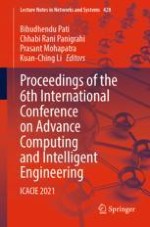This book gathers high-quality research papers presented at the 6th International Conference on Advanced Computing and Intelligent Engineering (ICACIE 2021) organized by Bhubaneswar Institute of Technology, Bhubaneswar, Odisha, India, during December 23–24, 2021. It includes sections describing technical advances and the latest research in the fields of computing and intelligent engineering. Intended for graduate students and researchers working in the disciplines of computer science and engineering, the proceedings also appeal to researchers in the field of electronics, as they cover hardware technologies and future communication technologies.
